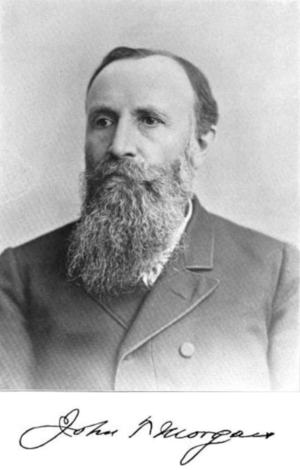John T. Morgan (judge) facts for kids
John T. Morgan was an important judge who lived from about 1830 to 1910. He served on the highest court in Idaho when it was still a territory, from 1879 to 1885. Later, after Idaho became a state, he joined the Idaho Supreme Court again from 1890 to 1896. He even became the Chief Justice, which is the top judge, from 1895 to 1896.
Contents
Early Life and Learning
John T. Morgan was born in a town called Hamburg, New York around 1830. He was the third son of James Clark Morgan, who was a farmer and a justice of the peace. When John was about 13, his family moved to Illinois, which was a very new state at the time.
He grew up on a farm and went to public schools in Monmouth, Illinois. To pay for more schooling, he worked as a teacher himself. In 1852, he started college at Lombard University in Galesburg, Illinois, and he graduated in 1855.
After college, he decided to become a lawyer. He studied law in the office of General Eleazer A. Paine for three years. General Paine later became a famous general in the Union Army during the Civil War. John Morgan then continued his law studies at Albany University in New York and later at the State Law School in Poughkeepsie, New York. He earned his law degree in 1856.
Starting His Law Career and Military Service
In 1856, John Morgan began working as a lawyer in Monmouth, Illinois. He quickly became very successful and had many clients.
When the American Civil War began, he joined the army to fight for the Union. On August 11, 1862, he enlisted with Company F of the 83rd Illinois Infantry Regiment. The governor of Illinois, Richard Yates, helped form this company. John Morgan was chosen to be its captain, and he served in this role until the war ended. He was honorably discharged from the army on June 26, 1865.
During the war, he also worked for two years as a provost marshal in Clarksville, Tennessee. This meant he was in charge of property that had been left behind by people who joined the Confederate army.
Political and Judicial Roles
After the Civil War, John Morgan went back to Monmouth, Illinois, and continued his law practice. In 1867, he was appointed as a registrar in bankruptcy, a job he held until 1879. During this time, he also became very active in politics.
In 1870, he was elected to the Illinois House of Representatives, where he served for two years. Then, in 1874, he was elected to the Illinois State Senate and served there until 1878. John Morgan was a member of the Republican Party.
On June 26, 1879, President Rutherford B. Hayes appointed John Morgan as the chief justice of the Supreme Court for the Idaho Territory. This meant he was the main judge for that court and also oversaw the district court for southeastern Idaho. President Chester A. Arthur reappointed him to this position. He served as a territorial judge until 1885, when President Grover Cleveland removed him from the role.
After leaving the territorial court, Morgan moved to Boise, Idaho, and started practicing law again. He became very successful, with many clients across eastern Idaho. He strongly supported Idaho becoming a state. When it was time to write Idaho's state constitution, he was chosen to be part of the group that created it. He also led the committee that focused on the legislative part of the new government.
In October 1890, John Morgan was elected as one of the justices of the Idaho Supreme Court. He served on this court until March 4, 1897, after which he returned to his law practice. In 1902, he even wrote a small book to help people find mining claims in Idaho.
Family and Passing
In November 1858, John Morgan married Maria Horroun, who was from Pennsylvania. They had four children together.
John T. Morgan passed away at his home in Boise on September 14, 1910, after having a paralytic stroke. The Idaho Supreme Court honored him in their official reports the following year.


